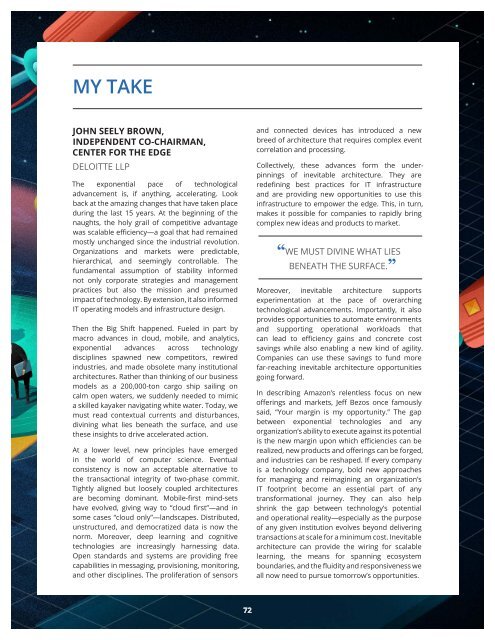Trending the trends Eight years of research
2kcf8xh
2kcf8xh
Create successful ePaper yourself
Turn your PDF publications into a flip-book with our unique Google optimized e-Paper software.
Tech Trends 2017 The kinetic enterprise<br />
Series title / Magazine title / Document Subtitle - style “header-subtitle”<br />
MY TAKE<br />
JOHN SEELY BROWN,<br />
INDEPENDENT CO-CHAIRMAN,<br />
CENTER FOR THE EDGE<br />
DELOITTE LLP<br />
The exponential pace <strong>of</strong> technological<br />
advancement is, if anything, accelerating. Look<br />
back at <strong>the</strong> amazing changes that have taken place<br />
during <strong>the</strong> last 15 <strong>years</strong>. At <strong>the</strong> beginning <strong>of</strong> <strong>the</strong><br />
naughts, <strong>the</strong> holy grail <strong>of</strong> competitive advantage<br />
was scalable efficiency—a goal that had remained<br />
mostly unchanged since <strong>the</strong> industrial revolution.<br />
Organizations and markets were predictable,<br />
hierarchical, and seemingly controllable. The<br />
fundamental assumption <strong>of</strong> stability informed<br />
not only corporate strategies and management<br />
practices but also <strong>the</strong> mission and presumed<br />
impact <strong>of</strong> technology. By extension, it also informed<br />
IT operating models and infrastructure design.<br />
Then <strong>the</strong> Big Shift happened. Fueled in part by<br />
macro advances in cloud, mobile, and analytics,<br />
exponential advances across technology<br />
disciplines spawned new competitors, rewired<br />
industries, and made obsolete many institutional<br />
architectures. Ra<strong>the</strong>r than thinking <strong>of</strong> our business<br />
models as a 200,000-ton cargo ship sailing on<br />
calm open waters, we suddenly needed to mimic<br />
a skilled kayaker navigating white water. Today, we<br />
must read contextual currents and disturbances,<br />
divining what lies beneath <strong>the</strong> surface, and use<br />
<strong>the</strong>se insights to drive accelerated action.<br />
At a lower level, new principles have emerged<br />
in <strong>the</strong> world <strong>of</strong> computer science. Eventual<br />
consistency is now an acceptable alternative to<br />
<strong>the</strong> transactional integrity <strong>of</strong> two-phase commit.<br />
Tightly aligned but loosely coupled architectures<br />
are becoming dominant. Mobile-first mind-sets<br />
have evolved, giving way to “cloud first”—and in<br />
some cases “cloud only”—landscapes. Distributed,<br />
unstructured, and democratized data is now <strong>the</strong><br />
norm. Moreover, deep learning and cognitive<br />
technologies are increasingly harnessing data.<br />
Open standards and systems are providing free<br />
capabilities in messaging, provisioning, monitoring,<br />
and o<strong>the</strong>r disciplines. The proliferation <strong>of</strong> sensors<br />
and connected devices has introduced a new<br />
breed <strong>of</strong> architecture that requires complex event<br />
correlation and processing.<br />
Collectively, <strong>the</strong>se advances form <strong>the</strong> underpinnings<br />
<strong>of</strong> inevitable architecture. They are<br />
redefining best practices for IT infrastructure<br />
and are providing new opportunities to use this<br />
infrastructure to empower <strong>the</strong> edge. This, in turn,<br />
makes it possible for companies to rapidly bring<br />
complex new ideas and products to market.<br />
“WE MUST DIVINE WHAT LIES<br />
BENEATH THE SURFACE.”<br />
Moreover, inevitable architecture supports<br />
experimentation at <strong>the</strong> pace <strong>of</strong> overarching<br />
technological advancements. Importantly, it also<br />
provides opportunities to automate environments<br />
and supporting operational workloads that<br />
can lead to efficiency gains and concrete cost<br />
savings while also enabling a new kind <strong>of</strong> agility.<br />
Companies can use <strong>the</strong>se savings to fund more<br />
far-reaching inevitable architecture opportunities<br />
going forward.<br />
In describing Amazon’s relentless focus on new<br />
<strong>of</strong>ferings and markets, Jeff Bezos once famously<br />
said, “Your margin is my opportunity.” The gap<br />
between exponential technologies and any<br />
organization’s ability to execute against its potential<br />
is <strong>the</strong> new margin upon which efficiencies can be<br />
realized, new products and <strong>of</strong>ferings can be forged,<br />
and industries can be reshaped. If every company<br />
is a technology company, bold new approaches<br />
for managing and reimagining an organization’s<br />
IT footprint become an essential part <strong>of</strong> any<br />
transformational journey. They can also help<br />
shrink <strong>the</strong> gap between technology’s potential<br />
and operational reality—especially as <strong>the</strong> purpose<br />
<strong>of</strong> any given institution evolves beyond delivering<br />
transactions at scale for a minimum cost. Inevitable<br />
architecture can provide <strong>the</strong> wiring for scalable<br />
learning, <strong>the</strong> means for spanning ecosystem<br />
boundaries, and <strong>the</strong> fluidity and responsiveness we<br />
all now need to pursue tomorrow’s opportunities.<br />
72


